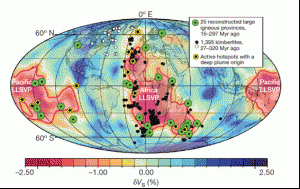Recently, I was casually asked by someone at a gathering whether any of the research I did was of use in the “real world”. The questioner was of course alluding to differences they perceive between “pure” and “applied” science and, in particular, to the issue of whether my research was of any direct practical benefit to human society. It was a fair question. The UK taxpayer funds my entire salary as well as the costs associated with my research (from overheads charged by the university for use of their buildings to flights to and from conferences and field areas). What’s in it for them?
Certain applications of palaeomagnetism are of direct practical use to society. For example, in dating past volcanic eruptions and measuring the emplacement temperature of lavas and pyroclastic flows, they can help in assessing volcanic risk. Palaeomagnetism can also help determine the tectonic stability of whole regions, assessing their suitability as depositories for high-level nuclear waste for example.
Nonetheless, most of the research projects I am involved with and indeed, most palaeomagnetic studies undertaken around the world, are purely “academic”. That is to say: they are not specifically aiming to achieve anything other than an increase in knowledge for its own sake. A common misconception is to think that this is the same as saying that they are of no practical benefit whatsoever. That is definitely not the case.
The main reason why practically all first-world nations invest in “blue skies” research is that they realise it pays dividends. Pure science, done well, contributes to a body of knowledge that, down the road, is the fuel for the innovations and improvements that we generally consider to be increasing civilisation.
By providing quantitative evidence for continental drift and sea-floor spreading, palaeomagnetic studies done back in the 1950s and 1960s played a crucial role in the acceptance of the theory of plate tectonics, first amongst Earth scientists and then by the public at large. This unifying theory now provides the underlying framework for, more or less, the entire subject of geology. How does the taxpayer benefit from funding this research more than 50 years ago? Materially, by the provision of cheap hydrocarbon and mineral resources that are found using models based on the plate tectonic paradigm. Bodily, by the much improved understanding of seismic and volcanic risk provided by the theory. Intellectually, by the awareness of this simple and beautiful aspect of our planet’s behaviour, now and for the last few decades, taught to every child in school (under the guise of “geography”, tragically).
So, palaeomagnetism had its moment of glory, but how about since then? Well, it continues to contribute to a body of knowledge about our planet and its history which is increasingly important to human society as it struggles to deal with global environmental change and resource depletion. To cite a recent example, Torsvik et al. (2010) used a plate motion reference frame based on palaeomagnetic data to show that most of the Earth’s diamond deposits occurred above the margins of large seismic structures visible at a depth of nearly
2900 km. As well as potentially being of fundamental scientific importance in linking surface geology to whole mantle convection processes, the study will also serve to guide prospectors in the search for future sources of diamonds (which don’t just make pretty jewellery).

Understanding the Earth’s magnetic field is also a smart thing for us to be investing in. The geomagnetic field performs a valuable service to humans in shielding technology on the Earth’s surface and in orbit around it from much of the torrent of charged particles sent
our way by the sun. From studying palaeomagnetic records, we now have evidence suggesting that the field has been weakening for around the last 2,500 years. Will it continue to do so requiring the makers of satellites and power-grids to invest in better protection from the solar wind in the future? Only by better documenting and understanding past geomagnetic variations will we be able to answer this question with any confidence.
Personally, I am convinced that the Earth sciences are poised for another big step forward in the coming decade, perhaps the biggest since the plate tectonic revolution. Studies of seismology, mantle and core convection, geodynamo behaviour, and plate tectonic history are on the brink of coming together into an interpretable whole. The result will be an overarching theory of planetary evolution that palaeomagnetism will play a crucial and fundamental role in formulating.
For me, you can’t get much more “real world” than that.


Leave a Reply